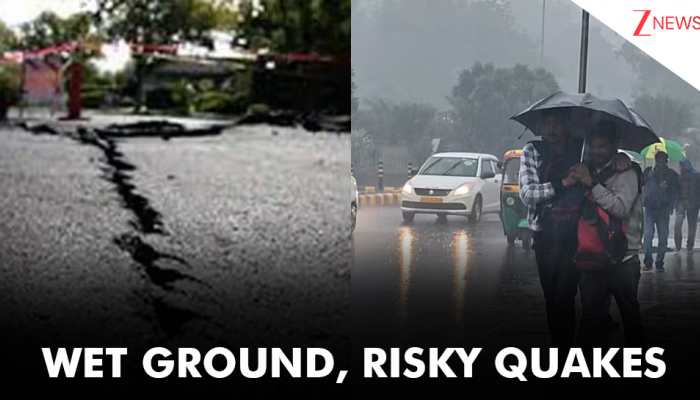Wet Ground, Risky Quakes: Why Delhi-NCR's Recent Tremor During Rain Is A Wake-Up Call For Safety?
A 4.4 magnitude earthquake rattled Delhi-NCR amid monsoon rains, highlighting heightened dangers. Know why wet ground makes quakes riskier and essential safety precautions for residents in seismic zones.
Trending Photos
) REPRESENTATIVE PICTURE
REPRESENTATIVE PICTUREAn earthquake with a magnitude of 4.4 hit Delhi and the National Capital Region (NCR) on Thursday morning, coinciding with ongoing monsoon rains. The tremor, centered near Rohtak in Haryana, occurred around 9:00 AM IST. It caused widespread panic as the two natural events raised concerns about potential dangers.
What Happened In Delhi-NCR?
The National Centre for Seismology (NCS) reported that the earthquake's shallow depth of 10 km (previously reported as 5 km) made the tremors strongly felt across Delhi, Noida, Greater Noida, Ghaziabad, and Gurugram. The shaking made frightened residents rush out of their homes onto the already wet streets. While there were no major damages or injuries reported right away, the combination of rain and seismic activity highlighted increased risks.
Why Is Delhi Prone To Earthquakes?
Delhi-NCR is classified within Seismic Zone IV, which means it has a moderate to high risk of seismic activity. This vulnerability is due to its distance of about 250 km from the Himalayan collision zone, where the Indian and Eurasian tectonic plates meet, building up stress that is released as earthquakes.
Several fault lines run through the Delhi area, including:
- Delhi-Haridwar Ridge
- Mahendragarh-Dehradun Fault
- Sohna Fault
- Yamuna River Lineament
These fault lines increase Delhi's susceptibility to earthquakes. Areas like Dhaula Kuan, which have underlying lakes, have historically experienced minor quakes every 2-3 years, including a 3.3 magnitude tremor in 2015.
Earthquake During Rains: A Heightened Risk?
The overlap of rainfall and earthquakes can significantly raise natural hazards. Monsoon rains in Delhi-NCR can weaken soil, building foundations, and road infrastructure, making them more vulnerable to earthquake damage.
Potential Dangers Include:
Damage to structures: Delhi-NCR has many high-rise buildings and older structures (such as Connaught Place, Trans-Yamuna areas, and unplanned settlements) that may not withstand earthquakes. Rain-softened soil and compromised foundations increase the risk of collapse, even from moderate quakes. Typically, a 4.4 magnitude quake causes minor damage, but its shallow depth intensified the shaking. A quake above 6.0 magnitude could cause major damage under these conditions.
Landslides and soil erosion: Saturated soil becomes unstable. Earthquake tremors can trigger landslides or soil erosion, especially in rapidly developing areas like Noida and Gurugram.
Impact on roads and transport: Rain-slick roads can crack during an earthquake, disrupting traffic and rescue efforts.
Aftershock risk: Dr. O.P. Mishra, Director of the National Centre for Seismology, noted that a 4.4 magnitude earthquake can be followed by aftershocks of up to 1.2 magnitude. Soil instability from the rain can make these aftershocks more dangerous.
The looming threat of a 'Great Himalayan Earthquake'
Scientists have long warned of a possible 'Great Himalayan Earthquake' (magnitude 8.0 or higher) due to built-up tectonic stress in the Himalayan region. Given Delhi's proximity to the Himalayas, it would experience significant effects. Heavy rainfall could worsen the impact, as saturated soil and weakened structures would be more prone to damage from a powerful quake.
While a 4.4 magnitude quake is generally seen as 'light' and less dangerous, its shallow depth and closeness to densely populated areas, combined with rain-damaged infrastructure, increased both its perceived and actual risks.
Safety Precautions During Earthquake And Rain
When an earthquake occurs during rainfall, extra precautions are necessary:
During An Earthquake:
- Drop, cover, hold on: If indoors, take cover under sturdy furniture, protect your head, and hold on until the shaking stops.
- Move to open space (if possible): If it is safe to do so, move to an open area away from buildings, trees, and power lines. Be careful on wet and slippery roads.
- Avoid lifts: Use stairs, as lifts may trap you during a quake.
- Stay away from hazards: Keep clear of windows, glass, and heavy objects that could fall.
Additional Rain-Specific Precautions:
- Wet roads: Be cautious when evacuating onto slippery, wet roads to avoid falls and injuries.
- Avoid flooded areas: After an earthquake, avoid low-lying areas in Delhi-NCR that are prone to waterlogging.
- Inspect buildings: If your building is old, check for cracks or damage after the quake. Weakened foundations from the rain could create additional dangers.
- Be prepared for aftershocks: Stay alert for smaller tremors (aftershocks). Consider downloading a reliable earthquake alert app like 'BhooKamp.'
Emergency Preparedness
- Emergency kit: Keep a kit with water, a flashlight, first-aid supplies, and essential medicines.
- Helpline numbers: Delhi Police advises using 112 for emergencies. Save this number in your phone.
- Family plan: Create an emergency plan with your family for meeting at a safe location during earthquakes or floods.
Awareness and training: Participate in regular drills for earthquake and flood readiness. Encourage such training in schools and workplaces. Consider contacting local authorities to discuss ways to make older buildings more earthquake-resistant.
Stay informed on all the latest news, real-time breaking news updates, and follow all the important headlines in india news andworld News on Zee News.
Live Tv



)
)
)
)
)
)
)
)
)
)
)
)
)
)
